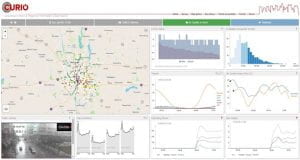In August 2021, I celebrated the 30th anniversary of my PhD from Ohio State Geography. In 1991, I left with my PhD to become an Assistant Professor at the University of Utah; a starting gig that lasted over 20 years. In 2013, when it was time to move on, OSU Geography was recruiting for the first endowed chair in the history of the department, the Bob and Mary Reusche Chair in Geographic Information Science. I applied, was interviewed, and they (surprisingly) offered the position. I am now back where I started, and I’m very proud and happy to be a faculty member in this stellar program. Interestingly, I now occupy an office that is directly above the basement office where graduate students were crammed during the late 1980s. After three decades, I have arrived 20 feet above where I started. This is an amusing observation, but also a metaphor.

Left: Harvey Miller in 1988.
Right: Harvey Miller in 2017
Geography was very different in the late 1980s: it was a conflicted discipline in search of its soul. Human and regional geographers criticized the “space cadets” in spatial analysts and the new subfield of Geographic Information Systems. In turn, the cadets had their own criticisms to lob back, while physical geographers and atmospheric scientists watched the slugfest from the sidelines. Meanwhile, Geography was reeling from decades of academic decline and departmental closures.
When I was a PhD student, I had the privilege of taking History of Geographic Thought from Edward J. “Ned” Taaffe, a former AAG President and department Chair who elevated OSU geography. When thinking about writing this blog, I went back to his 1973 AAG Presidential Address, “The Spatial View in Context.” This captures some of the soul-searching and defensiveness of the time: What is Geography? What is our value? I remember asking one day during the seminar – why do geographers apologize for their existence?
Fast forward to 2021. Geography is a more confident discipline. We have learned the value of diverse approaches to knowledge instead of skirmishing over who has the only path to the truth. Our external enemies have mostly retreated: few question the value of mapping, GIS and the holistic, integrative perspective of Geography (although higher education has its foes). Interdisciplinarity no longer feels like begging for a place at the table; rather, it is now a valued approach to understanding and addressing the complexity of the world and its problems. OSU Geography has maintained its traditional foci of human-environment, GIS/spatial analysis and atmospheric science, but we have arrived at a higher place.
We, as geographers, are still faced with the question – what is the core of Geography? What brings us together, besides a common TIU (Tenure Initiating Unit)? To me, the persistent quantitative/qualitative split in Geography is a false dichotomy, and I am pleased to see the new generation of geographers rejecting this false choice. I am also pleased to see OSU Geography adopt “justice” as a common touchstone for the program: environmental justice, social justice, climate justice and data justice. This is a crucial, cross-cutting challenge that demands the diverse perspectives encompassed by contemporary Geography.
A strong future for OSU Geography, and Geography at large, means continuing to work on what unites us. We are on higher ground, but there are still heights left to climb.
Bob and Mary Reusche Chair in Geographic Information Science
Professor of Geography and Director, CURA
The Ohio State University

